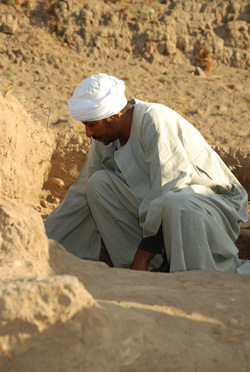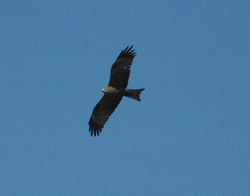We’re up and running


On Sunday, Abdel Aziz began looking for more of the mud brick found last week. He had no luck, as the northern part had been completely destroyed by the Roman pit and extensive animal burrow we found in 2008. In the pit, however, Abdel Aziz did turn up a large piece of what would once have been a very nice diorite statue; he was quite proud of his find.


Here it is a few days later, somewhat cleaned up. When complete, it depicted a kneeling man holding an offering bowl bigger than he was. The text around the bowl would have named him and included an offering formula to a god (or goddess). Unfortunately all we have left is the tail end of the inscription. Even though his face is gone, the high quality of the carving of the wig, kilt and hieroglyphs is evident.


The right side of the “bowl man”; on the right a cowrie shell (about 2 cm long) whose back has been carefully sawn off to make it lie flat. It immediately put me in mind of the symbolism in Judy Chicago’s The Dinner Party. According to our inspector, Hassan, cowrie shells are still used by fortune-tellers who throw shells on the ground and read the future in the patterns they form.

Here is the area north of Mut’s 1st Pylon at the end of the week. Our goal was to make as much sense of the brick as we could, which we have done, although the purpose of the foundations is not yet clear.

On the 18th we were happy to welcome Jacobus van Dijk back for another season. Jaap has an eagle eye for inscriptions, even climbing on top of awkward sphinx bases to have a good look.


Qufti Ayman Farouk Sharid is now working north of the Taharqa Gate trying to trace the wall that ran north from the gate, of which only a stub remains visible. We also want to figure out how that wall relates to the northern boundary wall of the approach to the gate. So far no answers to those questions, but Ayman has turned up yet another stub of wall, behind the meter stick, that is made up of unusually large bricks.


Mahmoud finished clearing the SW corner of the approach to the gate this week, revealing more paving running into the west baulk (left). To our surprise, he also found fragmentary remains of a mud brick structure (under the meter stick) built on the same level as the paving. Is it contemporary with the Taharqa Gate? We may never know as the rest of it lies under the later southern boundary wall of the the gate’s approach. Meanwhile, Abdullah Mousa, in the green galabiya, is now working in the NW corner of this square (right), taking down the strata of debris and walls left at the end of last season.

For the rest of the season we will be concentrating our efforts on the Taharqa Gate and the area to its west and south. Here you are looking south at the whole area at the end of work on Thursday. We have opened a new square on the high ground west of the gate (right), where Abdel Aziz will be working now that he’s finished with the brick in front of Mut’s 1st pylon.


Our first bird photos of the season. On Thursday Jaap caught this black kite soaring over the precinct (left) then swooping down on some unlucky creature who was about to become lunch. We’re glad you’re back, Jaap.

Richard Fazzini joined the museum as Assistant Curator of Egyptian Art in 1969 and served as the Chairman of Egyptian, Classical and Ancient Middle Eastern Art from 1983 until his retirement in June 2006. He is now Curator Emeritus of Egyptian Art, but continues to direct the Brooklyn Museum’s archaeological expedition to the Precinct of the Goddess Mut at South Karnak, a project he initiated in 1976. Richard was responsible for numerous gallery installations and special exhibitions during his 37 years at the museum. An Egyptologist specialized in art history and religious iconography, he has also developed an abiding interest in the West’s ongoing fascination with ancient Egypt, called Egyptomania. Well-published, he has lectured widely in the U.S. and abroad, and served as President of the American Research Center in Egypt, America’s foremost professional organization for Egyptologists.
